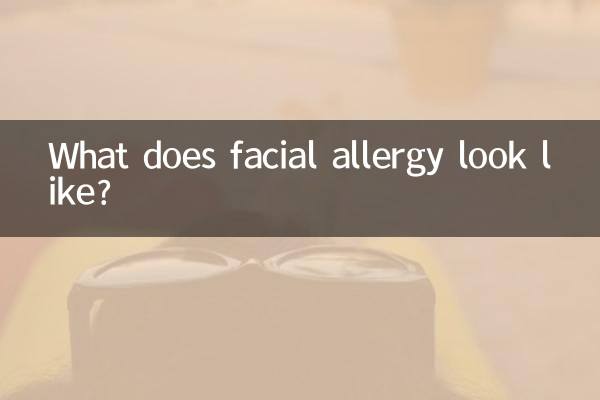What does facial allergy look like?
Facial allergies are a common skin problem that can be triggered by a variety of factors, such as cosmetics, food, environmental pollutants or seasonal pollens. Recently, there has been a lot of discussion on facial allergies across the Internet, especially spring pollen allergies and skin problems caused by masks. This article will combine hot topics in the past 10 days to analyze the symptoms, causes and countermeasures of facial allergies in detail, and provide structured data for reference.
1. Common symptoms of facial allergies

Facial allergies usually present with the following symptoms, which vary in severity from person to person:
| Symptoms | Description |
|---|---|
| Redness and swelling | Facial skin becomes red and swollen, possibly accompanied by a burning sensation |
| itching | The skin is unbearably itchy, and scratching may aggravate the symptoms |
| rash | Small papules or blisters appear, which may ooze fluid in severe cases |
| Dry and flaky | Dry, peeling, or even cracked skin |
| tingling sensation | A stinging or burning sensation on the skin after contact with the allergen |
2. Popular allergy-related topics in the past 10 days
By searching the entire network data, the following are allergy-related contents that have been highly discussed recently:
| topic | heat index | Main discussion points |
|---|---|---|
| Spring pollen allergies | 85% | How to tell the difference between pollen allergies and cold symptoms |
| Skin allergies caused by masks | 78% | Skin care methods after wearing a mask for a long time |
| Sensitization to cosmetic ingredients | 65% | Which cosmetic ingredients are likely to cause allergies |
| Facial manifestations of food allergies | 60% | First aid measures for food allergies such as seafood and nuts |
| Treatment of allergic dermatitis | 55% | Doctor-recommended anti-allergy medications and topical ointments |
3. Common causes of facial allergies
According to recent content shared by medical experts, the main causes of facial allergies include:
| Reason Category | specific factors | Proportion |
|---|---|---|
| environmental factors | Pollen, dust mites, air pollution | 35% |
| contact allergy | Cosmetics, skin care products, metal jewelry | 30% |
| food allergy | Seafood, nuts, dairy products, eggs | 20% |
| drug reaction | Antibiotics, analgesics, etc. | 10% |
| Others | UV rays, pressure, etc. | 5% |
4. How to deal with facial allergies
In response to recent popular discussions, the following countermeasures have been compiled:
| steps | Specific measures | Things to note |
|---|---|---|
| 1. Stop exposure to allergens | Immediately stop using suspect cosmetics or drugs | Record recent contacts for troubleshooting |
| 2. Gentle cleaning | Use warm water and mild cleansing products | Avoid rubbing vigorously or using exfoliating products |
| 3. Cold compress for relief | Apply a cold towel or ice pack to the allergic area | No more than 10 minutes at a time to avoid frostbite |
| 4. Drug use | Use antihistamines or topical ointments as directed by your doctor | Avoid using hormone-containing ointments on your own |
| 5. Medical advice | If symptoms persist or worsen, seek medical advice promptly. | Especially if you have severe symptoms such as difficulty breathing |
5. Tips to prevent facial allergies
Based on recent experiences shared by netizens and doctors’ advice, the following preventive measures deserve attention:
1.New cosmetics testing: Before use, test a small area behind the ear or inside the arm, and observe for 24 hours if there is no reaction before use.
2.Pay attention to weather changes: Reduce going out during pollen season, or wear protective equipment such as masks and goggles.
3.Diet records: People prone to allergies should record their diet and find suspected allergenic foods.
4.Strengthen skin barrier: Use skin care products containing ceramide and other ingredients to enhance skin resistance.
5.Regular cleaning: Change pillowcases and towels frequently to reduce exposure to dust mites.
Although facial allergies are common, discomfort can be effectively alleviated by correctly identifying symptoms, treating them promptly, and taking precautions. If symptoms persist or recur, it is recommended to promptly consult a dermatologist for professional diagnosis and treatment.

check the details

check the details